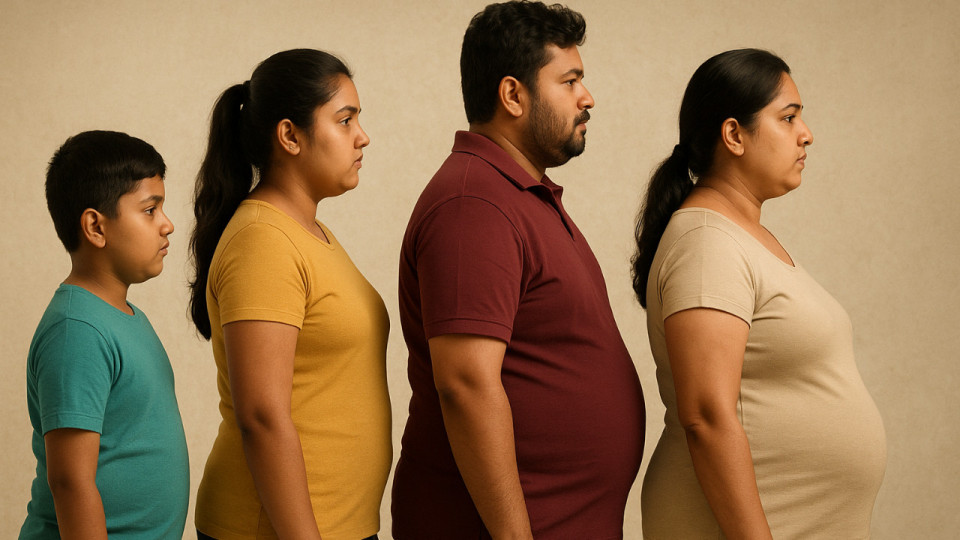
Sharp Rise in Overweight and Obesity Across All Age Groups in India, Says UNICEF (Image Source: ChatGPT)
India is seeing a fast rise in overweight and obesity among people of all ages, from young children to adults. A new UNICEF report shows that the number of under-five children with obesity in the country has more than doubled in just ten years. Globally too, obesity has overtaken underweight as the most common form of malnutrition among school-going children and teenagers, affecting nearly one in ten children about 188 million worldwide. Once linked mainly to richer nations, obesity is now growing rapidly in low- and middle-income countries, including India.
In South Asia, overweight was the least common in 2000. By 2022, rates grew almost five times higher among children aged 5-9, 10-14 and 15-19 years. Data from India’s National Family Health Survey (NFHS) show a rapid rise in overweight and obesity among under-five children up 127 per cent from 1.5 per cent to 3.4 per cent between NFHS-3 (2005–06) and NFHS-5 (2019–21). Among adolescents, overweight and obesity rose 125 per cent in girls (2.4 per cent to 5.4 per cent) and 288 per cent in boys (1.7 per cent to 6.6 per cent). For adults, prevalence climbed 91 per cent among women (12.6 per cent to 24 per cent) and 146 per cent among men (9.3 per cent to 22.9 per cent). UNICEF warns that India could have over 27 million children and adolescents (aged 5–19) living with obesity by 2030, making up 11 per cent of the global total.
India’s Economic Survey 2024–25 notes that ultra-processed food (UPF) sales jumped from USD 900 million in 2006 to USD 37.9 billion in 2019, with annual growth over 33 per cent. From 2011 to 2021, retail sales of these foods rose at a compound annual growth rate of 13.7 per cent. UNICEF highlights that high-fat, high-sugar, and high-salt fast foods and drinks are replacing fruits, vegetables, and traditional diets. Strong marketing and easy availability shape the choices of children and teenagers more than personal preference.
Several early-life conditions are adding to the problem — such as poor maternal nutrition and low-quality feeding practices for babies, including inadequate breastfeeding. Social norms where girls and women often eat last worsen the issue. At the same time, young people are eating more ultra-processed food and sugary drinks, moving less, and spending more time on screens. This is happening in a food environment dominated by processed products. Marie-Claude Desilets, Chief of Nutrition at UNICEF India, said India is facing a “triple burden” of malnutrition — stunting and wasting, micronutrient gaps, and obesity sometimes in the same family or even in the same person. She stressed that India has a chance now to prevent more children from becoming overweight.
The World Obesity Federation estimated obesity-related costs in India at nearly USD 29 billion — 1 per cent of GDP — in 2019. This may reach USD 839 billion or 2.5 per cent of GDP by 2060 if urgent steps are not taken. Unhealthy diets are now the top factor behind India’s disease burden, causing 56 per cent of it (ICMR-NIN, 2024). Dr. William Joe of the Institute of Economic Growth, Delhi, said poor diets fuel non-communicable diseases. Once obesity develops in childhood, it is very hard to reverse and raises the risk of diabetes, heart disease, high blood pressure and some cancers. It also harms household finances and self-esteem. India has launched several measures, including the Fit India Movement, Eat Right India, POSHAN Abhiyaan 2.0, and school wellness programmes. Guidance for reducing sugar and oil use in schools and offices has been introduced. Prime Minister Narendra Modi has urged families to cut cooking oil use by 10 per cent to improve health. India is also the first lower-middle-income country to adopt WHO’s best-practice policy to limit trans fats and has promoted “Eat Right” schools.
Arjan De Wagt, UNICEF India’s Deputy Representative for Programmes, said malnutrition is no longer only about undernutrition. The rise of obesity, driven by unhealthy foods and drinks, is pushing non-communicable diseases in children and youth. Without stronger policies such as clear front-of-pack nutrition labels, stricter rules on unhealthy food marketing, health taxes on junk food, and teaching nutrition skills to children India risks losing progress on child health. He added that government, civil society, businesses, and communities must work together to protect every child’s right to good nutrition.













Copyright © 2025 Top Indian News
